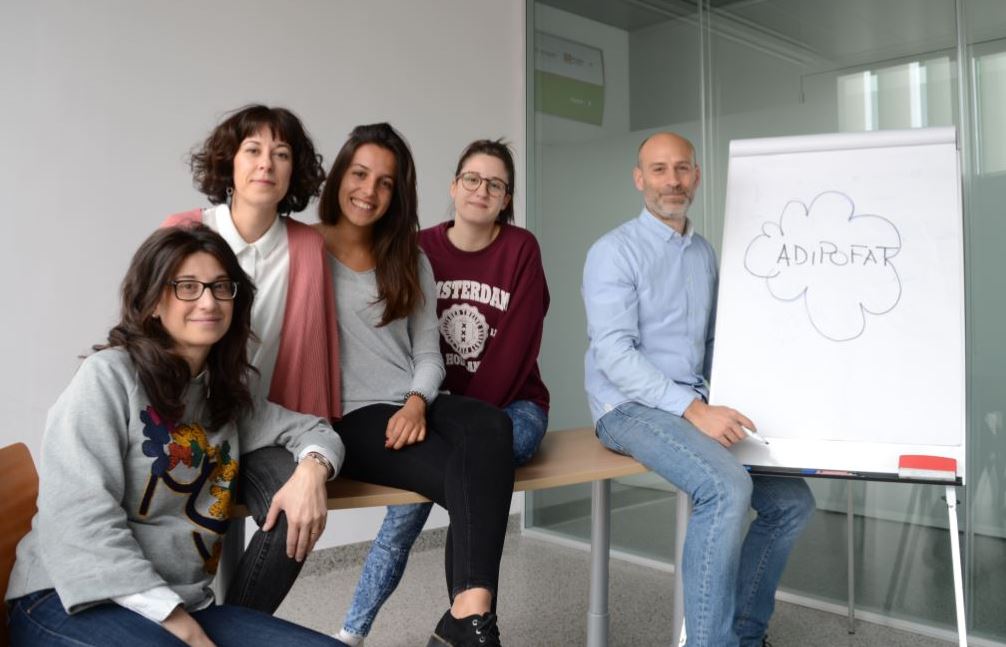Sobre el grupo
Investigador Principal
José Miguel Arbonés Mainar, Vanesa Bernal Monterde
Equipo
Alejandro Sanz París, Ana Belén Martínez Martínez, Carmen Yagüe Caballero, Diego Casas Deza, Mª Pilar García Sobreviela, Marina Clavel Millán, Miguel Angel Dobón Rascón, Raquel Del Moral Bergos, Silvia Lorente Cebrián, Virginia Rodrígo Vinué
Instituto Aragonés de Ciencias de la Salud
ADIPOFAT es un grupo multidisciplinar reconocido como grupo de referencia por el Gobierno de Aragón. Estudiamos los fenómenos metabólicos asociados a la obesidad con especial interés en los trastornos hepáticos. También las consecuencias de la desnutrición que ocurre en distintas patologías y las interacciones entre la dieta y los genes (Nutrición personalizada). Desde su nacimiento se han incorporado al grupo investigadores básicos y clínicos de distintas especialidades con el fin de producir una investigación traslacional de excelencia.
Líneas de Investigación
Expansibilidad del tejido adiposo. Biomarcadores para determinar el límite de expansión y las complicaciones de la obesidad
Enfermedad hepática por depósito de grasa y asociada a disfunción metabólica (MASLD)
Análisis de datos ómicos
Publicaciones más relevantes
de-Madaria E, Buxbaum JL, Maisonneuve P, García García de Paredes A, Zapater P, Guilabert L, Vaillo-Rocamora A, Rodríguez-Gandía MÁ, Donate-Ortega J, Lozada-Hernández EE, Collazo Moreno AJR, Lira-Aguilar A, Llovet LP, Mehta R, Tandel R, Navarro P, Sánchez-Pardo AM, Sánchez-Marin C, Cobreros M, Fernández-Cabrera I, Casals-Seoane F, Casas Deza D, Lauret-Braña E, Martí-Marqués E, Camacho-Montaño LM, Ubieto V, Ganuza M, Bolado F; ERICA Consortium. Aggressive or Moderate Fluid Resuscitation in Acute Pancreatitis. N Engl J Med. 2022 Sep 15;387(11):989-1000. doi: 10.1056/NEJMoa2202884. PMID: 36103415. FI-96,3
de-Madaria E, Sánchez-Marin C, Carrillo I, Vege S, Chooklin S, Bilyak A, Mejuto R, Mauriz V, Hegyi P, Márta K, Kamal A, Lauret-Braña E, Barbu S, Nunes V, Ruiz-Rebollo M, García Rayado G, Lozada-Hernandez E, Pereira J, Negoi I, Espina Cadena S, Hollenbach M, Litvin A, Bolado-Concejo F, Vargas R, Pascual-Moreno I, Singh V, Mira J. Design and validation of a patient-reported outcome measure scale in acute pancreatitis: the PAN-PROMISE study.. Gut. 2021. 10.1136/gutjnl-2020-320729. FI-23,1
Gratacos-Gines J, Ruz-Zafra P, Celada-Sendino M, Marti-Carretero A, Pujol C, Martin-Mateos R, Echavarria V, Frisancho L, Garcia S, Barreales M, Tejedor-Tejada J, Vazquez-Rodriguez S, Canete N, Fernandez-Carrillo C, Valenzuela M, Marti-Aguado D, Horta D, Quinones M, Bernal Monterde V, Acosta S, Artaza T, Pinazo J, Villar-Lucas C, Clemente-Sanchez A, Badia-Aranda E, Giraldez-Gallego A, Rodriguez M, Sancho-Bru P, Cabezas J, Ventura-Cots M, Fernandez-Rodriguez C, Aguilera V, Tome S, Bataller R, Caballeria J, Pose E, REHALC Registry Investigators . Recurrent alcohol-associated hepatitis is common and is associated with increased mortality. HEPATOLOGY. 2024. 10.1097/HEP.0000000000000825. FI-13
López Yus M, Casamayor Franco M, Soriano Godés J, Borlan Anson S, González Irazabal Y, García Sobreviela M, García Rodríguez B, Del Moral Bergos R, Calmarza Calmarza P, Artigas Martin J, Lorente Cebrián S, Bernal Monterde V, Sanz París A, Arbonés Mainar J. Isthmin-1 (ISM1), a novel adipokine that reflects abdominal adipose tissue distribution in individuals with obesity.. Cardiovascular Diabetology. 2023. 10.1186/s12933-023-02075-0. FI-8,5
Casas Deza D, Sierra Gabarda O, De Los Mozos Ruano A, Lamuela Calvo L, García López S, Fuentes Olmo J. Positron Emission Tomography/Computed Tomography-Based Diagnosis of Endotipsitis.. AMERICAN JOURNAL OF GASTROENTEROLOGY. 2021. 10.14309/ajg.0000000000000950. FI-8,5
Casas Deza D, Polo Cuadro C, de Francisco R, Vela González M, Bermejo F, Blanco I, de la Serna Á, Bujanda L, Bernal L, Rueda García J, Gargallo Puyuelo C, Fuentes-Valenzuela E, Castro B, Guardiola J, Ladrón G, Suria C, Sáez Fuster J, Pérez Gisbert F, Sicilia B, Gomez R, Muñoz Vilafranca C, Barreiro-De Acosta M, Peña E, Castillo Pradillo M, Cerrillo E, Calvet X, Manceñido N, Monfort I Miquel D, Marín S, Roig C, Marce A, de Piscina P, Betoré Glaria E, Martin-Cardona A, Teller M, Alonso Abreu I, Maroto N, Serrano Frago P, Gardeazabal D, Pérez-Martínez I, Febles González Á, Barrero S, Taxonera C, de la Filia I, Ezkurra-Altuna A, Madero L, Martín-Arranz M, Gomollón García F, Domènech E, García López S, ENEIDA registry by GETECCU . Initial management of intraabdominal abscesses and preventive strategies for abscess recurrence in penetrating Crohn's disease: a national multicenter study based on ENEIDA registry.. Journal of Crohns & Colitis. 2024. 10.1093/ecco-jcc/jjad184. FI-8,3
Casas Deza D, Lamuela Calvo L, Gomollón García F, Arbones-Mainar J, Caballol B, Gisbert J, Rivero M, Sanchez-Rodriguez E, Arias Garcia L, Gutierrez Casbas A, Merino O, Marquez L, Laredo V, Martin-Arranz M, Lopez Serrano P, Riestra Menendez S, Gonzalez-Munoza C, de Castro Parga L, Calvo Moya M, Fuentes-Valenzuela E, Esteve M, Iborra M, Dura Gil M, Barreiro-De Acosta M, Lorente-Poyatos R, Mancenido N, Calafat M, Rodriguez-Lago I, Guardiola Capo J, Antonia Payeras M, Morales Alvarado V, Tardillo C, Bujanda L, Munoz-Nunez J, Ber Nieto Y, Bermejo F, Almela P, Navarro-Llavat M, Martinez Montiel P, Rodriguez Gutierrez C, Van Domselaar M, Sese E, Martinez Perez T, Ricart E, Chaparro M, Jose Garcia M, Lopez-Sanroman A, Sicilia B, Orts B, Lopez-Garcia A, Martin-Larraz E, Perez-Calle J, de Francisco R, Garcia-Planella E, Domenech E, Garcia-Loper S, GETECCU . Effectiveness and Safety of Ustekinumab in Elderly Patients with Crohn's Disease: Real World Evidence From the ENEIDA Registry. Journal of Crohns & Colitis. 2023. 10.1093/ecco-jcc/jjac108. FI-8,3
Chaparro M, Garre A, Mesonero F, Rodriguez C, Barreiro-de Acosta M, Martinez-Cadilla J, Arroyo Villarino M, Mancenido N, Sierra-Ausin M, Vera-Mendoza I, Jose Casanova M, Nos P, Gonzalez-Munoza C, Martinez T, Bosca-Watts M, Calafat M, Busquets D, Girona E, Llao J, Dolores Martin-Arranz M, Piqueras M, Ramos L, Suris G, Bermejo F, Carbajo A, Casas Deza D, Fernandez-Clotet A, Garcia M, Ginard D, Gutierrez-Casbas A, Hernandez L, Lucendo A, Marquez L, Merino-Ochoa O, Rancel F, Taxonera C, Lopez Sanroman A, Rubio S, Domenech E, Gisbert J. Tofacitinib in Ulcerative Colitis: Real-world Evidence From the ENEIDA Registry. Journal of Crohns & Colitis. 2021. 10.1093/ecco-jcc/jjaa145. FI-8,3
Laiglesia L, Escoté X, Sáinz N, Felix-Soriano E, Santamaría E, Collantes M, Fernández-Galilea M, Colón-Mesa I, Martínez-Fernández L, Quesada-López T, Quesada-Vázquez S, Rodríguez-Ortigosa C, Arbonés Mainar J, Valverde Á, Martínez J, Dalli J, Herrero L, Lorente Cebrián S, Villarroya F, Moreno-Aliaga M. Maresin 1 activates brown adipose tissue and promotes browning of white adipose tissue in mice.. Molecular Metabolism. 2023. 10.1016/j.molmet.2023.101749. FI-7
Burgos R, García-Almeida J, Matía-Martín P, Palma S, Sanz París A, Zugasti A, Alfaro J, Fullana A, Continente A, Chicetru M, Malpartida K, Faes Á, Sánchez V, López M, Ortega A, Roldán J, Moreno C, Llanos P. Malnutrition management of hospitalized patients with diabetes/hyperglycemia and COVID-19 infection.. REVIEWS IN ENDOCRINE & METABOLIC DISORDERS. 2022. 10.1007/s11154-022-09714-z. FI-6,9
Otra Actividad
PROYECTOS ACTIVOS
LIPOPROTEIN PROFILING 4 HCV INFECTION
Hepatitis C Virus (HCV) associates with lipoproteins being secreted from the liver as highly infective lipoviro particles (LVP). These LVP markedly interfere with the host lipid metabolism, ultimately causing a wide array of extrahepatic manifestations of chronic infection such as liver steatosis and cardiovascular disease (CVD). Characterizing this impaired lipid homeostasis is hence of vital importance. Yet, previous research investigating the interaction of HCV genotypes and direct-acting antiviral (DAA) treatments on lipid metabolism leaves some aspects not yet addressed. We hypothesize that measuring the number and size of lipoprotein subclasses will provide a better tool to address HCV-mediated lipid remodeling rather than the classical measures of lipoprotein-borne cholesterol. Additionally, APOE is a structural component of HCV-LVP and plays important roles in HCV infection and virion assembly. However, previous epidemiological studies have also showed conflicting results regarding the differential role of APOE isoforms on circulating lipoproteins after DAA treatments. We hypothesize that those discrepant results may result as not-yet known interactions between APOE genotypes and HCV genotypes and their modulation by HCV treatments.
The aim of this study will be 1) to clinically and epidemiologically characterize the dyslipidemia caused by the HCV as well as the persistence of the altered lipid profile after the most common DAA treatments with the application of the DOSY method to calculate lipoprotein number and size, and 2) evaluate how polymorphisms in the APOE are associated with the HCV- and DAA- mediated lipid remodeling, accounting for HCV genotypes and different DAA treatments as confounding factors.
EXPANDIBILITY OF THE ADIPOSE TISSUE. BIOMARKERS TO DETERMINE THE LIMIT OF EXPANSION AND THE COMPLICATIONS OF OBESITY.
Obesity is a chronic disease of multifactorial origin defined as an accumulation of fat that causes health problems. The subcutaneous adipose tissue is able to expand during positive energy balance. However, expandability is limited and once surpassed there is an ectopic lipid deposition in other organs, which is the origin of the metabolic disorders associated with obesity.
OBJECTIVES: 1. Study of the biogenesis of subcutaneous adipose tissue, to determine the factors that set the limit of expansion.2. Develop noninvasive biomarkers that can be used in clinical practice to differentiate obese individuals in which the expansion limit has not yet been reached (benign obesity) of those who have exceeded the limit of expansion and require aggressive therapy.
METHODOLOGY: We included patients from the Department of Surgery who will donate a sample of subcutaneous fat (prospective study). Abdominal imaging techniques will be performed to determine the level of adipose tissue expansion, metabolomics in plasma and fat to identify metabolites produced by adipocytes in the process of expansion and transcriptomics in adipose tissue to determine changes in gene expression related with the adipogenic process. Biomarkers of interest will be tested in vitro and in a validation cohort. These biomarkers will decrease the economic and health care burden of obesity on society by allowing an early detection of pathological obese individuals.

